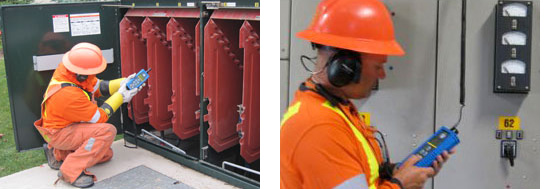Ultrasound inspection may be performed on both open access and enclosed electrical equipment at all voltages (low, medium and high). When electrical apparatus such as switchgear, transformers, insulators or disconnects and splices fail, the results can be catastrophic. This is just as true in industrial plants as it is in the power transmission and distribution side. Electrical discharges such as arcing, tracking or, in higher voltages, corona have the potential to create equipment failure and costly downtime. In addition, the problems of RFI and TVI impact on our valuable communication networks. In enclosed equipment, if left undetected, these conditions can become a source of an arc flash incident, which can result in severe injury or death. Arcing, tracking and corona produce ultrasound and are detected with a variety of ultrasonic instruments.


How Ultrasound Electrical Detection Works
Arcing, tracking and corona all produce ionization which disturbs the surrounding air molecules. An Ultrasonic probe detects high frequency sounds produced by these emissions and translates them (via heterodyning) down into the audible ranges. The specific sound quality of each type of emission is heard in headphones while the intensity of the signal is observed on a display panel. These sounds may be recorded and analyzed through ultrasound spectral analysis software for a more accurate diagnosis. Normally, electrical equipment should be silent, although some equipment such as transformers may produce a constant hum, or some steady mechanical noises. These should not be confused with the erratic, sizzling frying, uneven and popping sound of an electrical discharge.
Detection Method
Before beginning any inspection of electric equipment, always ensure compliance with all safety procedures and rules. Be familiar with in CSA Z462 (NFPA 70E -USA). Essentially, as in generic leak detection, the area of inspection is scanned starting at a high sensitivity level. To determine the location of the emission, reduce the sensitivity and follow the sound to the loudest point. If it is not possible to remove covers, or plates or doors, scan around the seams and vent slots. Any potentially damaging discharges should be detected.
When it is not possible to get close to the test equipment, such as for safety reasons or while inspecting over-head power lines, DDP Technology use a parabolic microphone and dish.
